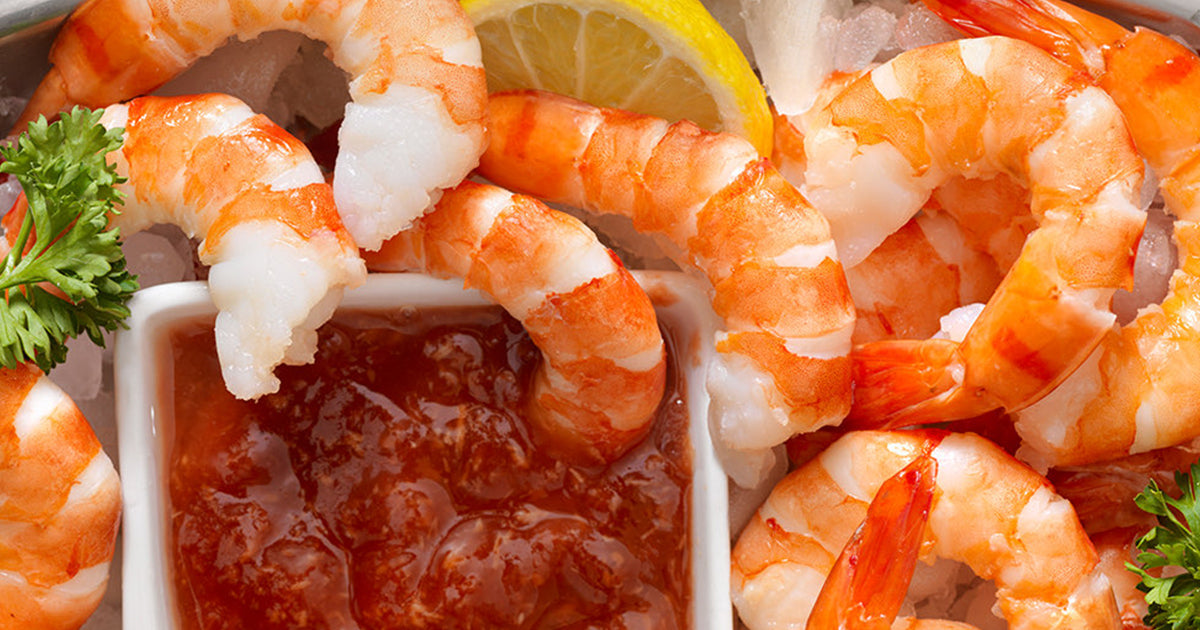Shrimp Size Chart

While browsing the Fulton Fish Market site or your local grocery store, you may notice that there are a variety of different shrimp sizes to choose from. You know that a colossal shrimp is bigger than a small shrimp, but what does the size difference really mean?
In the seafood industry, shrimp size is measured by the number of shrimp in one pound. On most bags of shrimp, you will find a smaller number followed by a slash and then a larger number. For example, 71-90 would indicate that there are 71 to 90 shrimp per pound. As a general rule, the smaller the shrimp size the larger the count.
Different shrimp sizes are better in different recipes and can require different cooking methods. For example, smaller shrimp are typically found in salads while larger shrimp are used as appetizers or a main course.
There are no industry standards for shrimp sizing names but here is how we refer to our sizes.

How Are Shrimp Sized?
Colossal (16-20) & Super Colossal (8-12, 13-15)
Shrimp Size:
Colossal shrimp average about 16 to 20 shrimp per one-pound bag. You will get 4-5 shrimp per serving and they come in at about 0.75 oz per shrimp.
Super colossal shrimp are the largest shrimp in the market. You will get anywhere from 8 to 15 shrimp per 1 lb bag and 2-3 shrimp per serving. This comes out to around one shrimp per ounce.
Cooking:
Since super colossal shrimp are so large they may require up to 15 minutes to bake or cook. You often see colossal shrimp in a shrimp cocktail or even stuffed with crab and baked. They are almost always the focal point of the dish.
Jumbo (21-25, 26-30)
Shrimp Size:
In a one-pound bag, you get anywhere from 21 to 30 jumbo shrimp. You get from 5-7 shrimp per 3oz serving and each individual shrimp weighs about half an ounce.
Cooking:
Since jumbo shrimp are noticeably larger they take about 10 minutes to bake or grill. They are usually the focal point of the meal and are great grilled with light seasoning, sautéed in butter and garlic, or even included in a nice stir-fry.
Medium (41-50, 51-60) & Large (31-40)
Shrimp Size:
Medium shrimp run anywhere from 41 to 60 shrimp per one-pound bag. This is about 10 to 15 shrimp per 3 oz serving and 0.23 oz per shrimp.
Large shrimp are about 31 to 40 shrimp per pound making for about 8 or 9 shrimp per serving. Each individual shrimp weighs about 0.33 oz.
Cooking:
Medium shrimp and large shrimp only takes about 4-6 minutes to pan-sear. Medium and large shrimp go great in pastas like shrimp scampi or seared in a little butter and placed on top of a steak.
Small (71-90)
Shrimp Size:
For small shrimp, you usually get anywhere from 71 to 90 shrimp per one-pound bag. This equates to about 18 shrimp per standard 3 oz serving, meaning that each individual shrimp weighs about 0.17 oz.
Cooking:
Small shrimp cook extremely quickly. You’ll want to make sure you pay close attention while cooking them, so they don’t come out rubbery due to over-cooking. Small shrimp work great in shrimp salads and dips.
Additional Considerations
How much weight do shrimp lose when peeled?
Shrimp sizes are based on the form in which they are purchased. This means colossal shrimp (peeled and deveined) will have more meat than colossal shrimp (shell, tail, and head on). On average, shrimp with the heads on are two sizes larger than they would be with the heads removed. A shrimp with just the shell and tail will be about one size larger than they would be with these removed. For example, if you purchased a colossal 16-20 shrimp with the head on, it would be approximately a jumbo 26-30 size shrimp with the head removed. Once the shell is removed, it will be approximately a large 31-40 size shrimp.
Why do my shrimp seem smaller after cooking?
Like all seafood, shrimp will shrink some in size when it cooks due to water weight loss. Shrimp and seafood without preservatives added will shrink less because the preservatives often cause the product to retain excess moisture, which is released during the cooking process.
